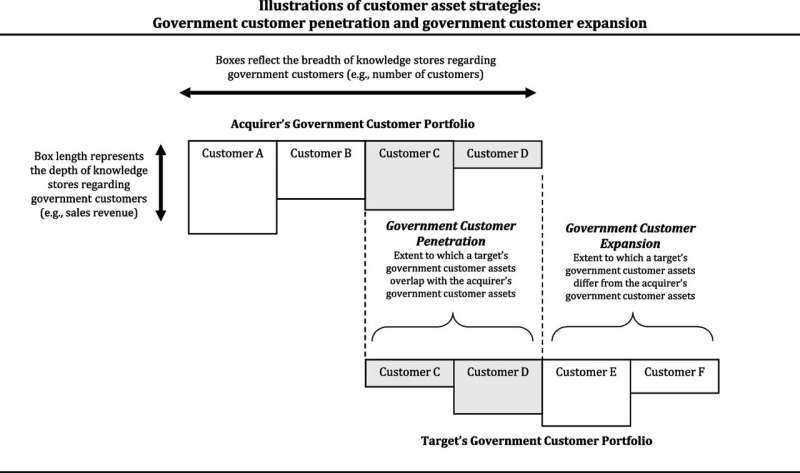This article has been reviewed according to Science X's editorial process and policies. Editors have highlighted the following attributes while ensuring the content's credibility:
fact-checked
peer-reviewed publication
trusted source
proofread
Avoiding the 'nothingburger' effect in government contractor mergers and acquisitions

In love and business alike, the laws of attraction can be obscure. Companies pursue mergers and acquisitions (M&A) for a host of reasons ranging from gaining market share to gaming the tax system. In his recently published research, Brett Josephson, associate dean for executive development and associate professor of marketing at George Mason University, pondered one particularly mysterious M&A motivator: customer strategy.
"We suspected one of the primary reasons firms were buying each was for the other company's customer assets," Josephson says. "But the information was hidden behind the firewalls of these companies. Companies are not going to reveal their customer portfolio unless they are forced to."
To test his hypothesis, Josephson turned to the government contracting (GovCon) sector, where vendor disclosures are a requirement for doing business. Moreover, M&A activity in the federal GovCon ecosystem has been extremely robust in recent years, as the competitive conditions increasingly favor entities with scale advantages.
"In the business-to-government (B2G) space, companies have difficulty achieving organic growth due to regulatory oversight, budgeting challenges and the unique nature of this sector," Josephson says. "So they often turn to M&A's to fuel growth and increase profitability, but we really don't know whether and when these activities actually lead to increased returns."
Josephson's paper for Journal of the Academy of Marketing Science, co-authored by Shuai Yan of University of Stavanger and Ju-Yeon Lee of Iowa State University, poses the question: Do equity markets prefer M&As between companies who serve the same customers, or different ones?
In theory, either strategy could work. Doubling down with shared customers—which the paper terms customer penetration—could reinforce key relationships with major government agencies and take advantage of scale benefits. Gaining access to new customers— or customer expansion—has obvious virtues of access to new markets and revenue streams, but could be thwarted by the steep learning curve B2G firms face when onboarding new clients.
The researchers analyzed market response to 422 M&A deals during the period 2001-2017, where both target and acquirer were government contractors. For each M&A pairing, they assessed customer penetration and customer expansion by comparing value generated by contracts from shared customers against those from customers new to the acquirer.
They found that investors reacted positively to news of M&As that were heavily weighted toward customer expansion—in other words, a customer expansion focus was associated with higher short-term cumulative abnormal returns (firm share price increased more than expected). The opposite was true of M&As where customer penetration dominated. Deals that were more evenly split between the two strategies also met with a slightly negative investor response.
Josephson suggests that markets are generally aware of the uphill battle that may lie ahead for contractors that consolidate in order to win more business from an existing customer. Thanks to the unique power dynamic that occurs when your client is also your potential regulator, these attempts can backfire if a government agency perceives that the deal would inordinately increase its dependency on a single vendor.
Highly specific vendor requirements can also make consolidated firms ineligible to retain the government contracts they previously serviced as separate entities. These are just a couple of the reasons why investors perceive customer penetration as generally unlikely to pay off in the short term.
"With customer penetration, it's hard to change pricing schema and net 'unexpected' new revenue," Josephson further explains. "Your income statement may change, but that's not an exciting story for investors. There's an impression of diminishing returns."
The "nothingburger" effect of customer penetration M&A was diminished when product-based contractors absorbed service-based companies. The mix of offerings added a dimension of diversification to the deal that apparently interested investors. With customer expansion M&As, it had the opposite effect—firm values went down as investors may have considered it a risky proposition to try integrating these two doubly different entities.
However, both types of M&A were generally more successful when the customers serviced by target and acquirer were in growth areas of the federal budget, e.g. cybersecurity or anti-terrorism in the post-9/11 period. "Government contracting companies are looking for fast-moving streams, with budgets rising faster in certain sectors than the federal budget as a whole," Josephson says.
He cautions that his findings may not equally apply to all M&As in the B2G space, because not all deals are geared toward share price maximization. For example, it is often the case that companies would rather merge than compete with one another. But these sorts of anti-competitive deals are the ones most likely to raise regulator eyebrows and prompt accusations of favoritism.
The particularities of the B2G sector may complicate the applicability of these findings to the broader economy. However, tighter regulatory oversight places some industries in a roughly analogous position to B2G. Josephson says, "We believe our findings will stand up within highly regulated markets such as telecom and pharma that have a large base of commercial customers."
More information: Shuai Yan et al, The effect of customer asset strategies on acquisition performance in business-to-government markets, Journal of the Academy of Marketing Science (2023). DOI: 10.1007/s11747-023-00955-1
Journal information: Journal of the Academy of Marketing Science
Provided by George Mason University





















